Osmotic Membrane Distillation Crystallization of NaHCO3
Abstract
:1. Introduction
2. Materials and Methods
2.1. Chemicals
2.2. Equipment
2.3. Overall Mass Transfer Coefficient and Transmembrane Flux Calculation
3. Results and Discussion
3.1. Influence of the Fluid Dynamics
3.2. Influence of the Feed Concentration
3.3. Influence of the Feed Temperature
3.4. Crystalline Phases
4. Conclusions
5. Patents
Author Contributions
Funding
Institutional Review Board Statement
Informed Consent Statement
Data Availability Statement
Conflicts of Interest
Appendix A
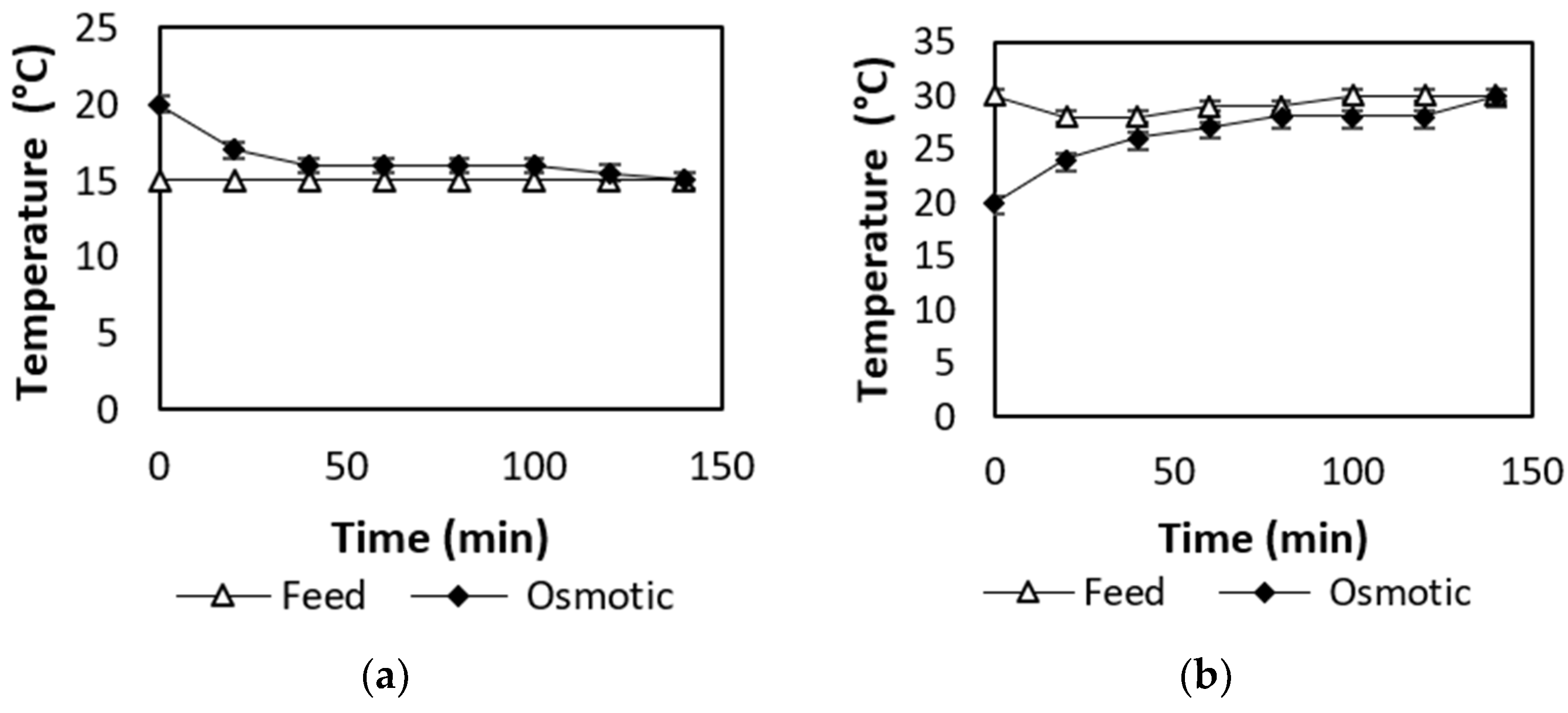
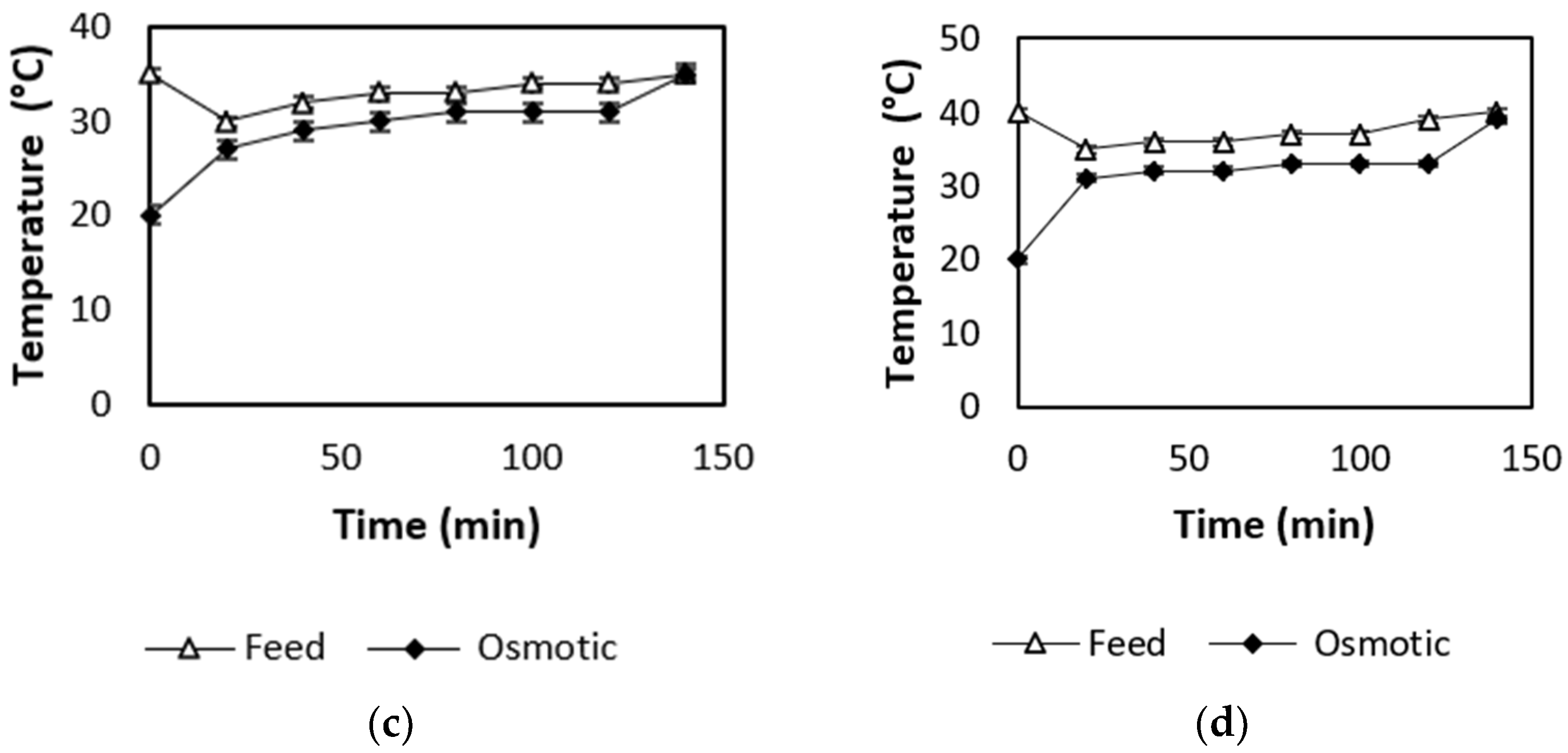
Appendix B
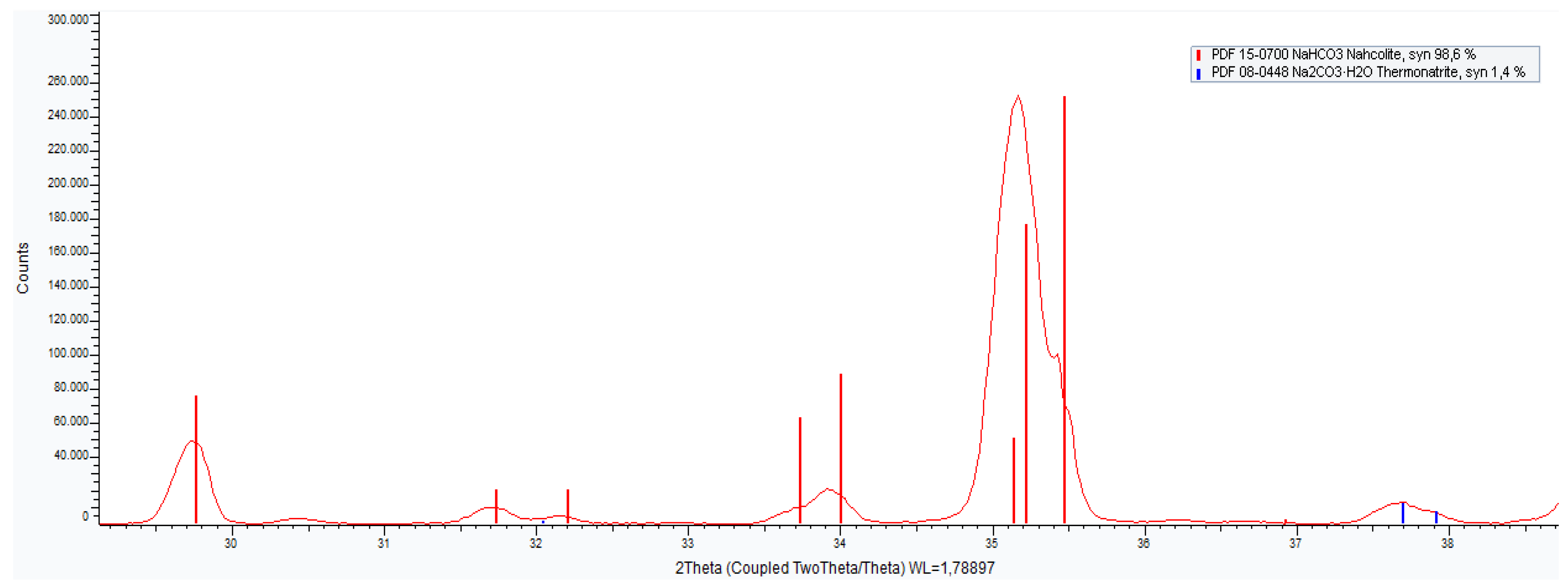
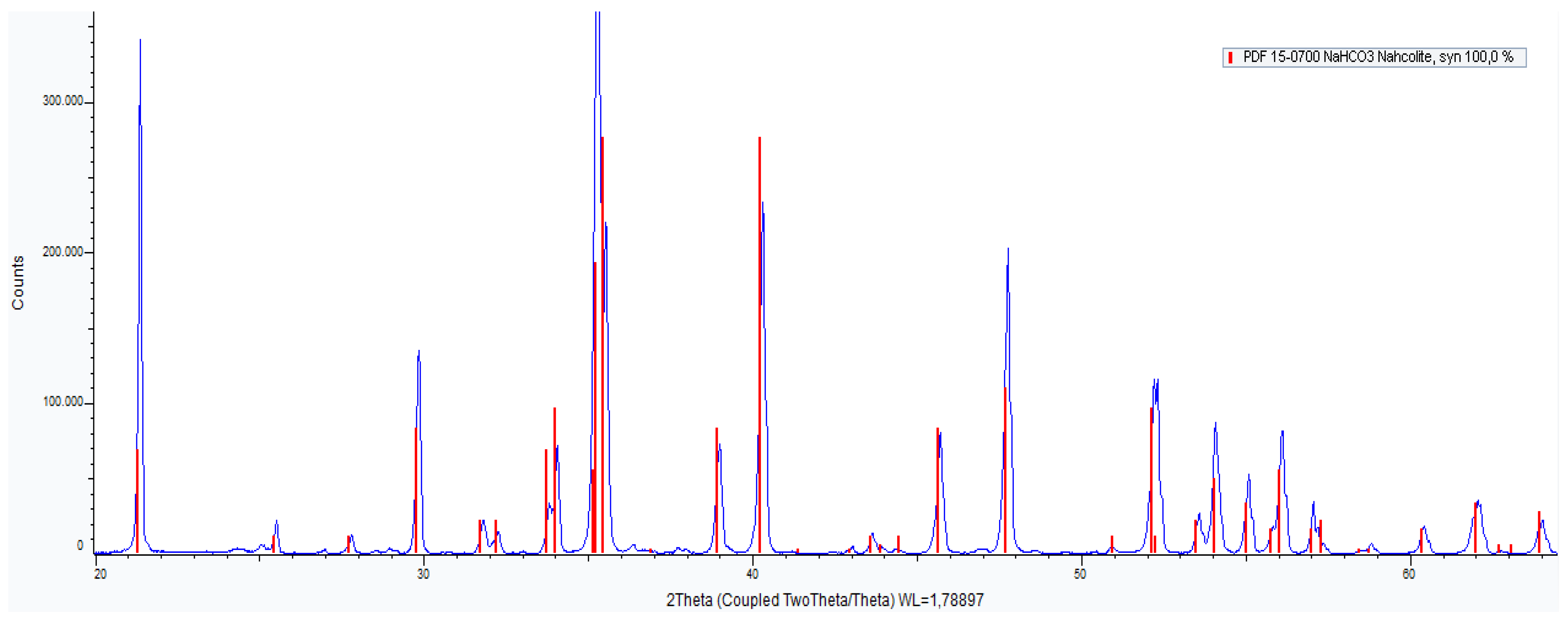
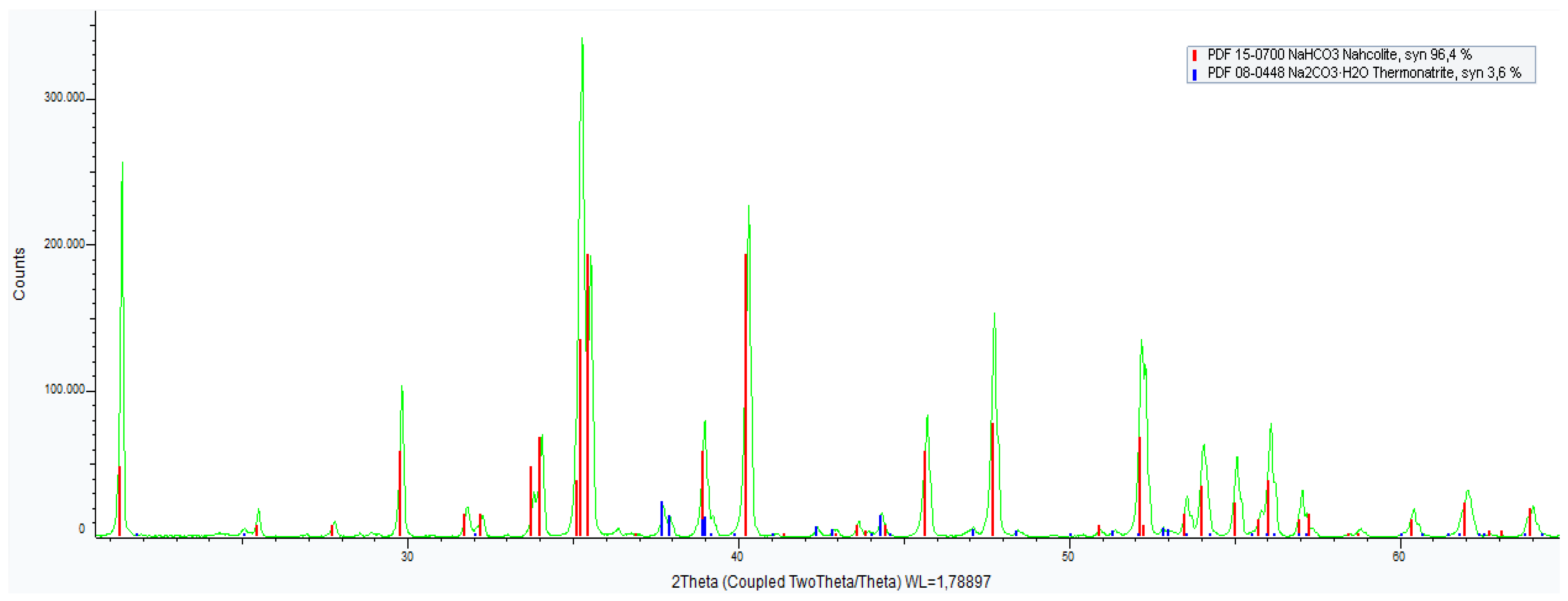
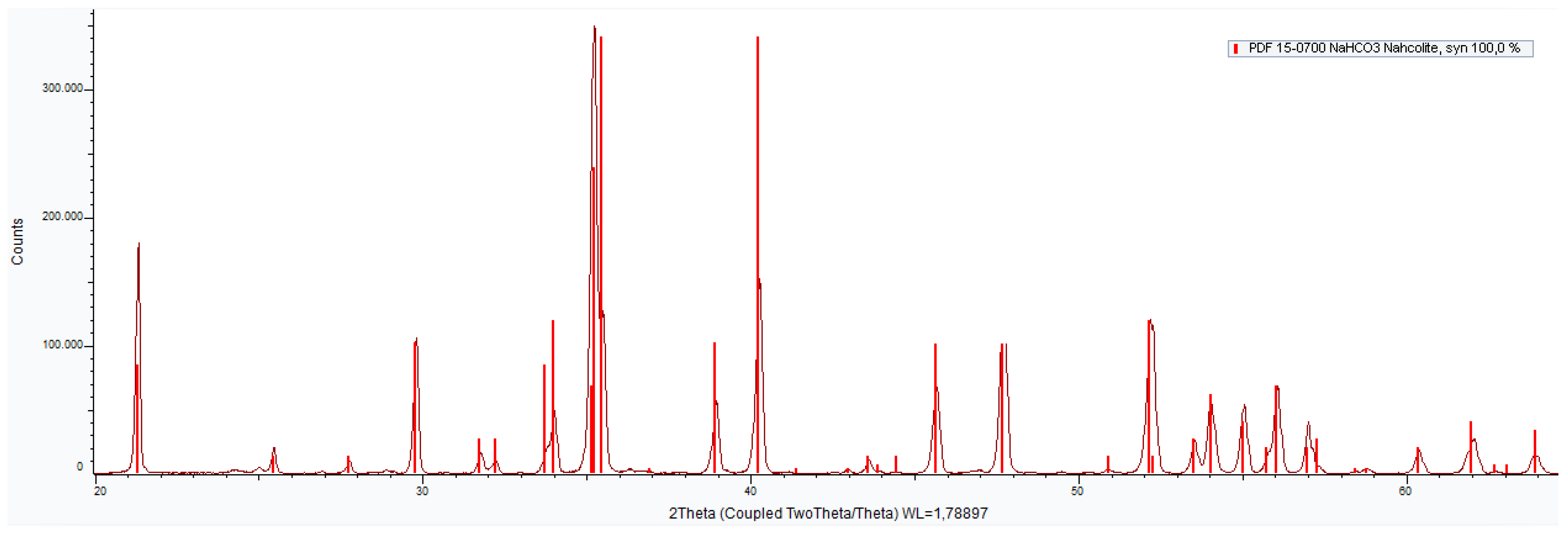

References
- Edenhofer, O.; Madruga-Pichs, R.; Sokona, Y.; Minx, J.C.; Farahani, E.; Kadner, S.; Seyboth, K.; Adler, A.; Baum, I.; Brunner, S.; et al. (Eds.) Climate Change 2014 Mitigation of Climate Change Working Group III Contribution to the Fifth Assessment Report of the Intergovernmental Panel on Climate Change; IPCC: Cambridge, UK; New York, NY, USA, 2014. [Google Scholar]
- Cassano, A.; Conidi, C.; Drioli, E. A Comprehensive Review of Membrane Distillation and Osmotic Distillation in Agro-Food Applications. J. Membr. Sci. Res. 2020, 6, 304–318. [Google Scholar] [CrossRef]
- Wang, J.; Li, F.; Lakerveld, R. Process Intensification for Pharmaceutical Crystallization. Chem. Eng. Process. Process Intensif. 2018, 127, 111–126. [Google Scholar] [CrossRef]
- Salmón, I.R.; Luis, P. Membrane Crystallization via Membrane Distillation. Chem. Eng. Process. Process Intensif. 2018, 123, 258–271. [Google Scholar] [CrossRef]
- di Profio, G.; Salehi, S.M.; Curcio, E.; Drioli, E. Membrane Crystallization Technology. In Comprehensive Membrane Science and Engineering, 2nd ed.; Elsevier: Amsterdam, The Netherlands, 2017; Volume 3, pp. 297–317. [Google Scholar]
- Drioli, E.; di Profio, G.; Curcio, E. Progress in Membrane Crystallization. Curr. Opin. Chem. Eng. 2012, 1, 178–182. [Google Scholar] [CrossRef]
- Kramer, H.; Anisi, F.; Burak, E.; Stankiewicz, A.I. Membrane Crystallization Technology and Process Intensification. In Comprehensive Membrane Science and Engineering; Drioli, E., Lidietta, G., Fontananova, E., Eds.; Elsevier: Amsterdam, The Netherlands, 2017; Volume 4, pp. 1–7. [Google Scholar]
- Chabanon, E.; Mangin, D.; Charcosset, C. Membranes and Crystallization Processes: State of the Art and Prospects. J. Membr. Sci. 2016, 509, 57–67. [Google Scholar] [CrossRef]
- Drioli, E.A.C.; Curcio, E. Membrane Contactors: Fundamentals, Applications and Potentialities; Elsevier: Amsterdam, The Netherlands, 2011. [Google Scholar]
- Drioli, E.; Curcio, E.; di Profio, G. State of the Art and Recent Progresses in Membrane Contactors. Chem. Eng. Res. Des. 2005, 83, 223–233. [Google Scholar] [CrossRef]
- Alkhudhiri, A.; Darwish, N.; Hilal, N. Membrane Distillation: A Comprehensive Review. Desalination 2012, 287, 2–18. [Google Scholar] [CrossRef]
- Luis, P. Fundamental Modeling of Membrane Systems: Membrane and Process Performance; Elsevier: Amsterdam, The Netherlands, 2018. [Google Scholar]
- Nagy, E. Basic Equations of Mass Transport through a Membrane Layer, 2nd ed.; Elsevier: Amsterdam, The Netherlands, 2019. [Google Scholar]
- Macedonio, F.; Ali, A.; Drioli, E. Membrane Distillation and Osmotic Distillation. In Comprehensive Membrane Science and Engineering; Elsevier: Amsterdam, The Netherlands, 2017; Volume 3, pp. 282–296. [Google Scholar]
- Zhu, Y.; Haut, B.; Halloin, V.; Delplancke-Ogletree, M.P. Investigation of Crystallization Kinetics of Sodium Bicarbonate in a Continuous Stirred Tank Crystallizer. J. Cryst. Growth 2005, 282, 220–227. [Google Scholar] [CrossRef]
- Saberi, A.; Goharrizi, A.S.; Ghader, S. Precipitation Kinetics of Sodium Bicarbonate in an Industrial Bubble Column Crystallizer. Cryst. Res. Technol. 2009, 44, 159–166. [Google Scholar] [CrossRef]
- Jiang, S.; Zhang, Y.; Li, Z. A New Industrial Process of NaHCO3 and Its Crystallization Kinetics by Using the Common Ion Effect of Na2CO3. Chem. Eng. J. 2019, 360, 740–749. [Google Scholar] [CrossRef]
- Salmón, I.R.; Janssens, R.; Luis, P. Mass and Heat Transfer Study in Osmotic Membrane Distillation-Crystallization for CO2 Valorization as Sodium Carbonate. Sep. Purif. Technol. 2017, 176, 173–183. [Google Scholar] [CrossRef]
- Sparenberg, M.C.; Ruiz Salmón, I.; Luis, P. Economic Evaluation of Salt Recovery from Wastewater via Membrane Distillation-Crystallization. Sep. Purif. Technol. 2020, 235, 116075. [Google Scholar] [CrossRef]
- Sparenberg, M.C.; Hanot, B.; Molina-Fernández, C.; Luis, P. Experimental Mass Transfer Comparison between Vacuum and Direct Contact Membrane Distillation for the Concentration of Carbonate Solutions. Sep. Purif. Technol. 2021, 275, 119193. [Google Scholar] [CrossRef]
- Brito, M.M.; Jullok, N.; Rodríguez, Z.N.; van der Bruggen, B.; Luis, P. Membrane Crystallization for the Recovery of a Pharmaceutical Compound from Waste Streams. Chem. Eng. Res. Des. 2014, 92, 264–272. [Google Scholar] [CrossRef]
- Sandler, S.I. Chemical, Biochemical, and Engineering Thermodynamics, 5th ed.; Wiley: Hoboken, NJ, USA, 2014; ISBN 1118915178/9781118915172. [Google Scholar]
- Pitzer, K.S.; Peiper, J.C. Activity Coefficient of Aqueous Sodium Bicarbonate. J. Phys. Chem. 1980, 84, 2396–2398. [Google Scholar] [CrossRef]
- Boubakri, A.; Hafiane, A.; al Tahar, S.B. Nitrate Removal from Aqueous Solution by Direct Contact Membrane Distillation Using Two Different Commercial Membranes. Desalination Water Treat. 2015, 56, 2723–2730. [Google Scholar] [CrossRef]
- Creusen, R.; van Medevoort, J.; Roelands, M.; van Renesse van Duivenbode, A.; Hanemaaijer, J.H.; van Leerdam, R. Integrated Membrane Distillation–Crystallization: Process Design and Cost Estimations for Seawater Treatment and Fluxes of Single Salt Solutions. Desalination 2013, 323, 8–16. [Google Scholar] [CrossRef]
- Luo, L.; Zhao, J.; Chung, T.S. Integration of Membrane Distillation (MD) and Solid Hollow Fiber Cooling Crystallization (SHFCC) Systems for Simultaneous Production of Water and Salt Crystals. J. Membr. Sci. 2018, 564, 905–915. [Google Scholar] [CrossRef]
- Shi, W.; Li, T.; Tian, Y.; Li, H.; Fan, M.; Zhang, H.; Qin, X. An Innovative Hollow Fiber Vacuum Membrane Distillation-Crystallization (VMDC) Coupling Process for Dye House Effluent Separation to Reclaim Fresh Water and Salts. J. Clean. Prod. 2022, 337, 130586. [Google Scholar] [CrossRef]
- Bush, J.A.; Vanneste, J.; Leavitt, D.; Bergida, J.; Krzmarzick, M.; Kim, S.J.; Ny, C.; Cath, T.Y. Membrane Distillation Crystallization of Ammonium Nitrate Solutions to Enable Sustainable Cold Storage: Electrical Conductivity as an in-Situ Saturation Indicator. J. Membr. Sci. 2021, 631, 119321. [Google Scholar] [CrossRef]
- Zhu, Y.; Demilie, P.; Davoine, P.; Cartage, T.; Delplancke-Ogletree, M.P. Influence of Calcium Ions on the Crystallization of Sodium Bicarbonate. J. Cryst. Growth 2005, 275, e1333–e1339. [Google Scholar] [CrossRef]
- Ga, R.S.; Seckler, M.M.; Witkamp, G.-J. Reactive Recrystallization of Sodium Bicarbonate. Ind. Eng. Chem. Res. 2005, 44, 4272–4283. [Google Scholar] [CrossRef]
- Abdel-Rahman, Z.A.; Hamed, H.H.; Khalaf, F.K. Optimization of Sodium Bicarbonate Production Using Response Surface Methodology (RSM). Diyala J. Eng. Sci. 2018, 11, 22–28. [Google Scholar] [CrossRef]
- Yoo, M.; Han, S.J.; Wee, J.H. Carbon Dioxide Capture Capacity of Sodium Hydroxide Aqueous Solution. J. Environ. Manag. 2013, 114, 512–519. [Google Scholar] [CrossRef] [PubMed]
- Wang, Y.; Cheng, Y.-S.; Yu, M.-G.; Li, Y.; Cao, J.-L.; Zheng, L.-G.; Yi, H.-W. Methane Explosion Suppression Characteristics Based on the NaHCO3/Red-Mud Composite Powders with Core-Shell Structure. J. Hazard. Mater. 2017, 335, 84–91. [Google Scholar] [CrossRef] [PubMed]
- Wang, Q.; Li, Z. A Modified Solvay Process with Low-Temperature Calcination of NaHCO3 Using Monoethanolamine: Solubility Determination and Thermodynamic Modeling. AIChE J. 2019, 65, e16701. [Google Scholar] [CrossRef]

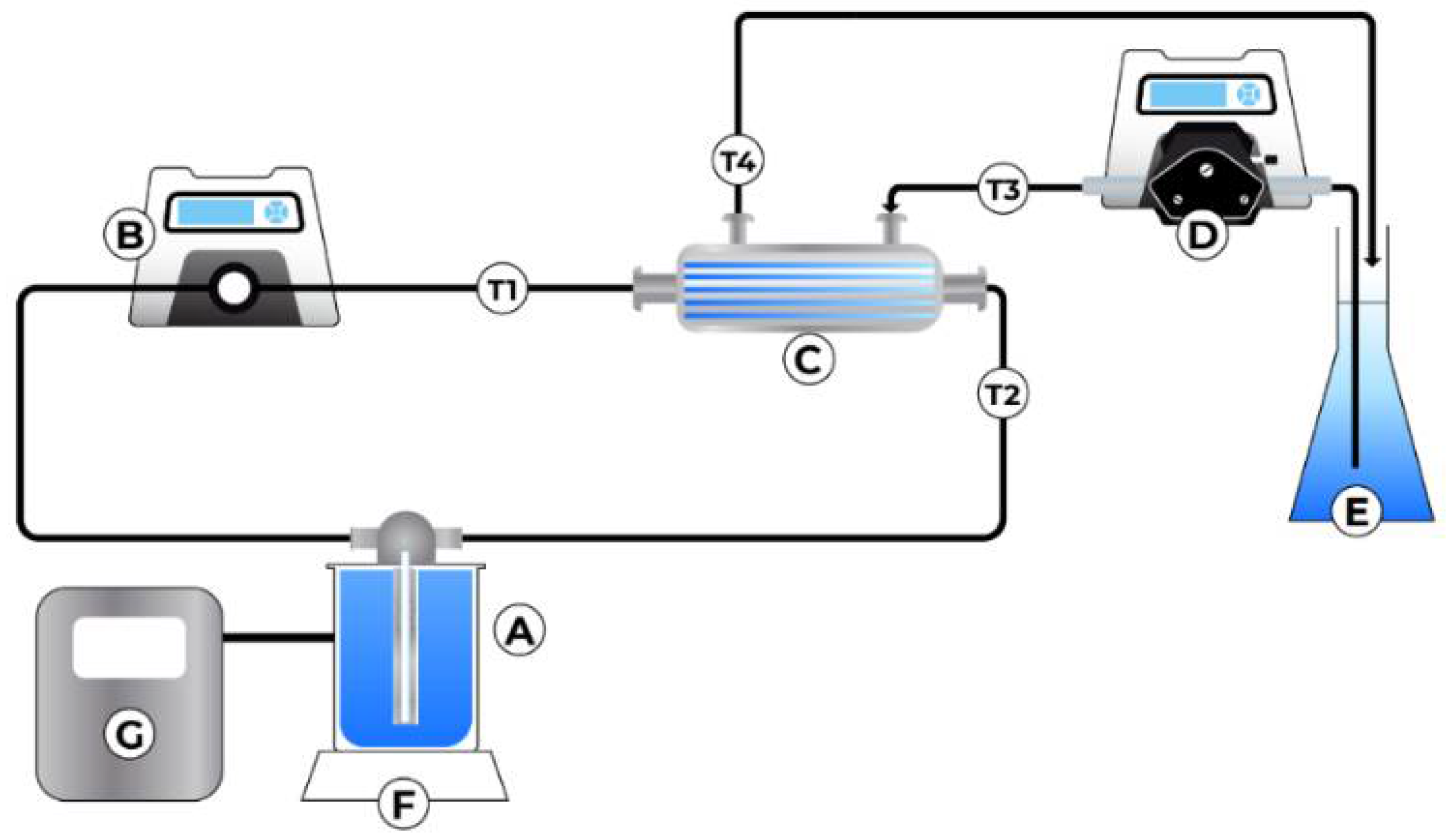

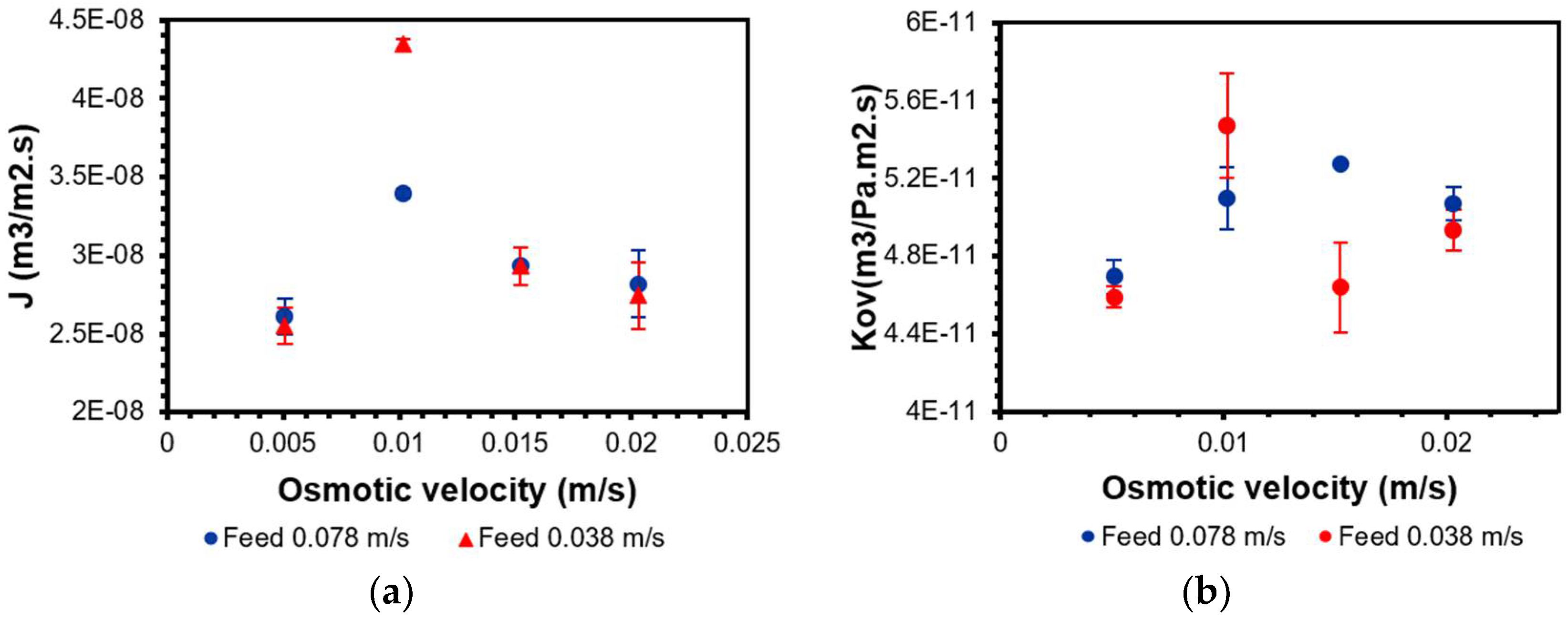
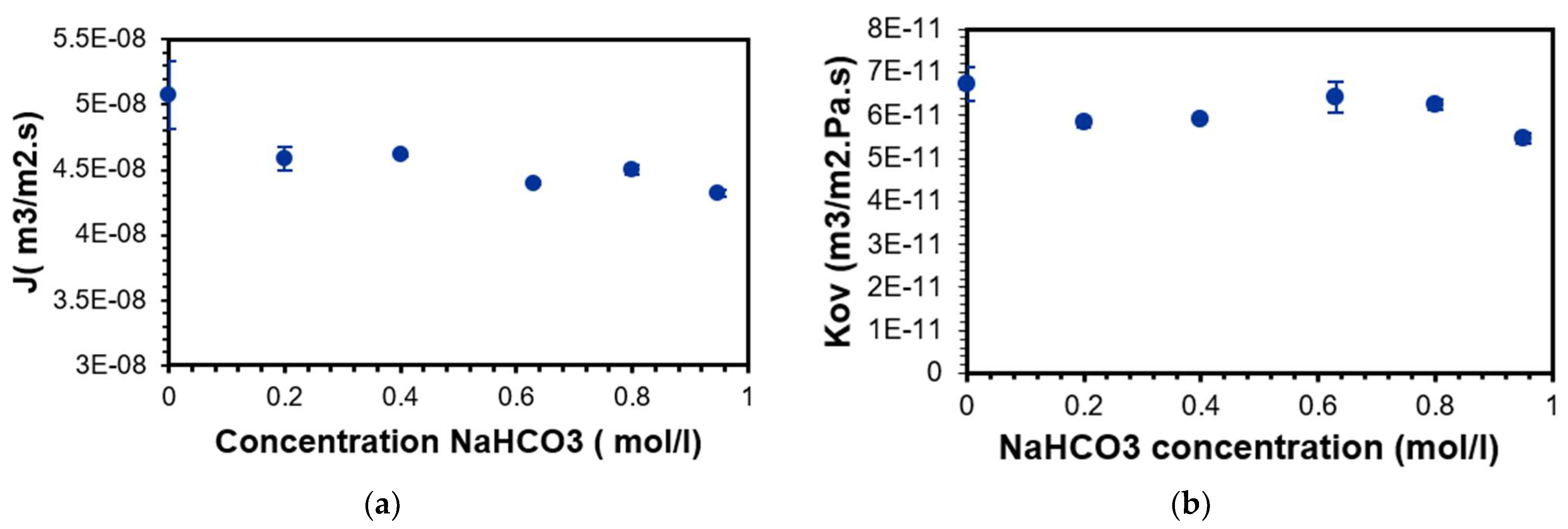
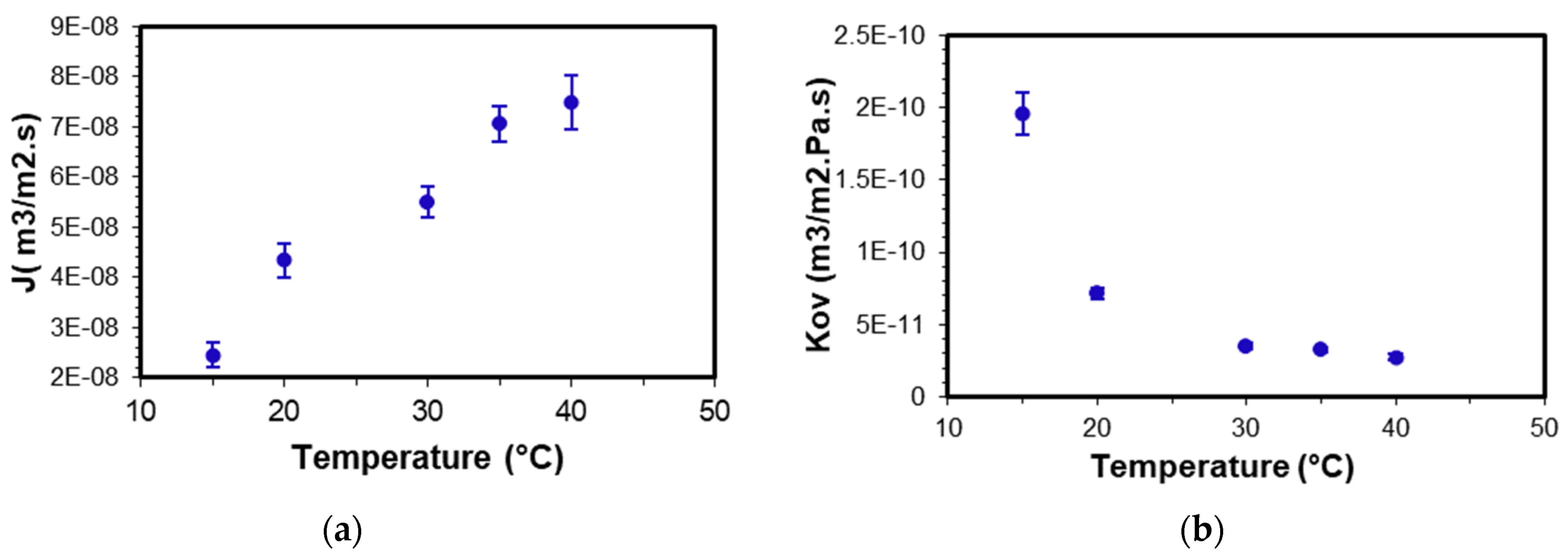
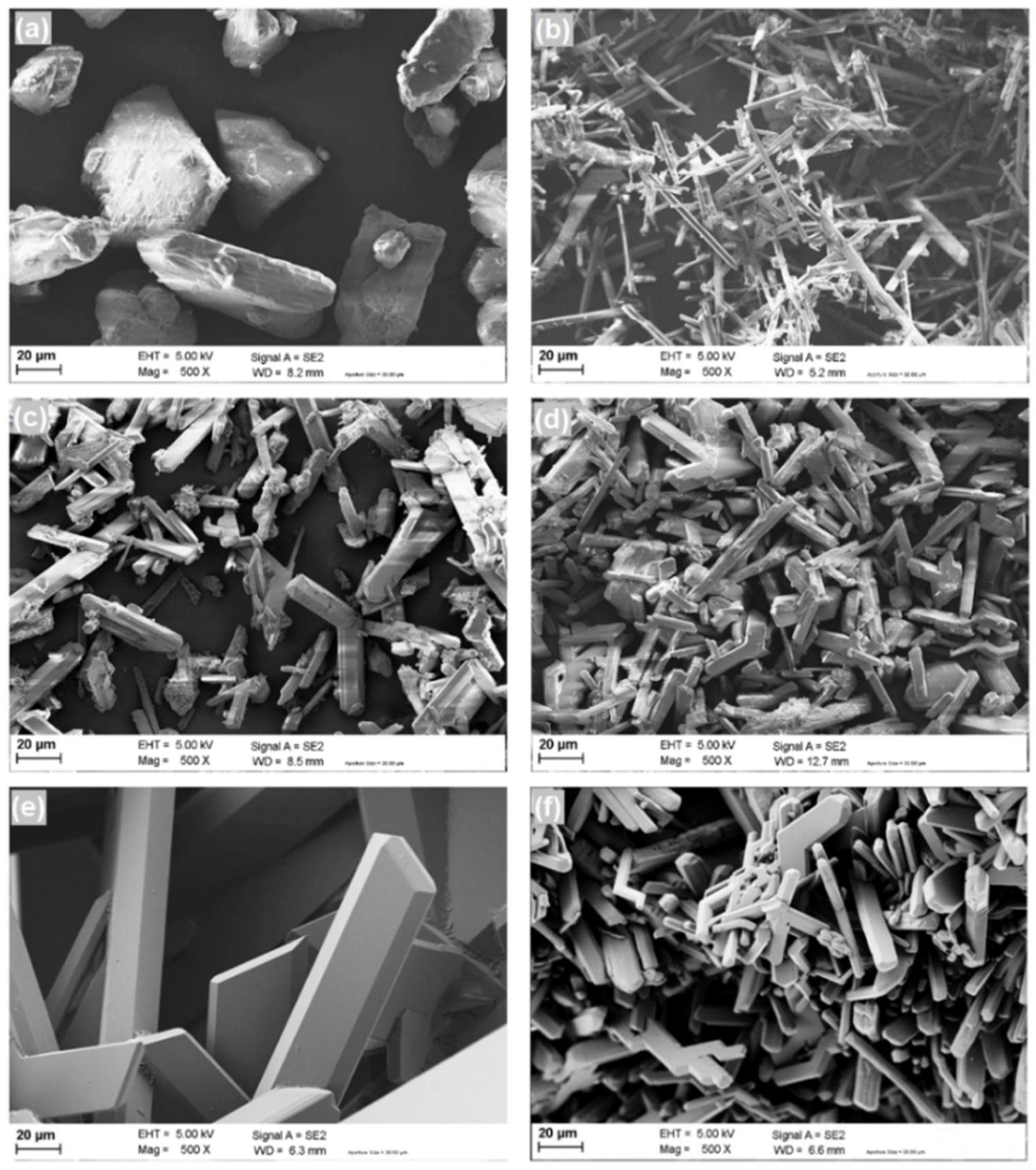

| Contactor Type | Liqui-Cel® 1 × 5.5 MiniModuleTM |
|---|---|
| Module configuration | Hollow fibers |
| Housing/potting | Polycarbonate/polyurethane |
| Membrane type | X50 microporous fiber |
| Membrane material | Pp (hydrophobic) |
| Porosity | 40% |
| Effective pore size | 0.04 µm |
| Inner diameter/outer diameter | 300 µm/220 µm |
| Active surface area | 0.18 m2 |
| Number of fibers | 2300 |
| Reference | Membrane Process | Membrane Type | Material | Crystal Product | Jmax (kg/m2·h) | Kmax (m3/m2 Pa s) |
|---|---|---|---|---|---|---|
| [18] | OMCD | Hollow fiber | PP | NaCO3 | 0.138 | 6.53 × 10−11 |
| [20] | VMD/DCMD | Hollow fiber | PP | NaCO3 | 0.8 and 0.11 | 4.8 × 10−11 and 3.7 × 10−11 |
| [25] | MDC | Flat sheet | PTFE | CaCO3, NaCl, KC | 6 | - |
| [26] | MDC | Hollow fiber | PVDF/PTFE particles | NaCl | 8 | - |
| [27] | VMDC | Hollow fiber | PVDF | Al(NO3) | 9.6 | - |
| [28] | MDC | Flat sheet | Elongated PTFE | NH4NO3 | 2–5 | - |
| This study | OMCD | Hollow fiber | PP | NaCO3 | 0.269 | 6.41 × 10−11 |
Publisher’s Note: MDPI stays neutral with regard to jurisdictional claims in published maps and institutional affiliations. |
© 2022 by the authors. Licensee MDPI, Basel, Switzerland. This article is an open access article distributed under the terms and conditions of the Creative Commons Attribution (CC BY) license (https://creativecommons.org/licenses/by/4.0/).
Share and Cite
Garcia Alvarez, M.; Sang Sefidi, V.; Beguin, M.; Collet, A.; Bahamonde Soria, R.; Luis, P. Osmotic Membrane Distillation Crystallization of NaHCO3. Energies 2022, 15, 2682. https://doi.org/10.3390/en15072682
Garcia Alvarez M, Sang Sefidi V, Beguin M, Collet A, Bahamonde Soria R, Luis P. Osmotic Membrane Distillation Crystallization of NaHCO3. Energies. 2022; 15(7):2682. https://doi.org/10.3390/en15072682
Chicago/Turabian StyleGarcia Alvarez, Mar, Vida Sang Sefidi, Marine Beguin, Alexandre Collet, Raul Bahamonde Soria, and Patricia Luis. 2022. "Osmotic Membrane Distillation Crystallization of NaHCO3" Energies 15, no. 7: 2682. https://doi.org/10.3390/en15072682






